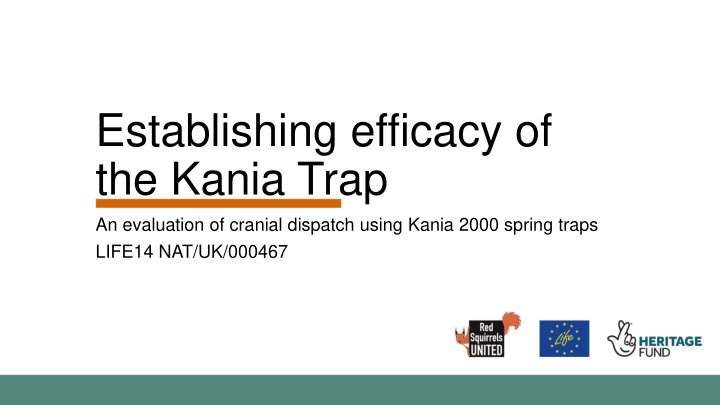



Establishing efficacy of the Kania Trap An evaluation of cranial dispatch using Kania 2000 spring traps LIFE14 NAT/UK/000467
Introduction • RSU NI trialling use of the Kania Trap for dispatch in partnership with North Down Red Squirrel and Pine Marten Group. • The group hosted an MSc student from Queens University to assess the effectiveness of the technique in the field in grey squirrels.
Spring Trap Approval Order (2) Paragraph (1) is subject in all cases to the following conditions — (a)the spring trap must be used in accordance with the instructions (if any) provided by the manufacturer, (b)the trap must be used in a manner that minimises the likelihood of its killing, taking or injuring non-target species, whilst not compromising the purpose for which it is being used, and (c)the spring traps specified in column 1 of Schedule 1 and any equivalent spring traps are subject to the conditions specified in column 2 of Schedule 1.
Spring Trap Approval Order SCHEDULE 1 Kania Trap 2000 manufactured by or under the The trap shall be used only for the purpose of killing authority of Kania Industries Inc., 63 Centennial grey squirrels, mink, stoats, rats, mice and other Road, British Columbia, V9R 6N6, Canada. small ground vermin (except for those species listed in Schedules 5 and 6 of the Wildlife (Northern Ireland) Order 1985. The trap must be set within the housing provided by the manufacturer.
What is a clean kill? • An Agreement on International Humane Trapping Standards was brokered in 1997 to resolve a trade embargo threatened by the EU in 1991 against countries that traded fur from wild animals caught by inhumane methods • The AIHTS is binding on all EU member states, and Defra has indicated that the UK will remain committed to it after Brexit. • Defra is implementing AIHTS by means of the least possible change (GWCT 2019).
What is a clean kill? Stoat American Marten Sable Pine Marten
What is a clean kill? Stoat American Marten Sable Pine Marten
Methodology • During a six week phase of control, field data was collected to assess the effectiveness of this new dispatch technique against a number of variables. • Effectiveness was assessed on two levels; time taken for the squirrel to enter the trap and whether the trap produced a clean kill. • International standards used by APHA require trap to cause irreversible unconsciousness in 80% of animals within 5 minutes of trigger, our parameters were set at irreversible consciousness within 1 minutes of trigger. • Time required to enter trap was also tested and Kania traps with modified housing, particularly Perspex fronts were tested vs non modified Kania traps.
Equipment set up
Results • A total of 76 squirrels were euthanized throughout the 6 week cull, 83 % were classified as “clean” kills and 17% were classified as “unclean” kills. • 80% of clean kills were noted in unmodified traps (n=30) and 85% in traps modified with a Perspex window (n=46). • Animal agitation investigated as a factor in variance, significant difference between cleanliness of kill for agitated (n=38; 79%) and non-agitated animals (n=38; 87%)
Results Trap efficiency varied Time taken for the with gender; 93% in squirrel to enter the spring trap ranged from males (n=55), 83% in females (n=25) and 1 second to 1402 25% in juveniles (n=10) seconds; the average time was 3 minutes 47 seconds. (Trap combs or other techniques not used to encourage squirrel into trap)
Conclusion • Trap efficacy in adults is high (93% males and 83% in females) but is low in juveniles ( 25%) as such caution is required post breeding windows. • Kania trap usage makes dispatch of grey squirrels much more palatable for community groups. • Modifications of the Kania Trap housing will increase efficacy. Modification of the trap itself is not allowed.
Establishing efficacy of the Kania Trap An evaluation of cranial dispatch using Kania 2000 spring traps LIFE14 NAT/UK/000467
Recommend
More recommend